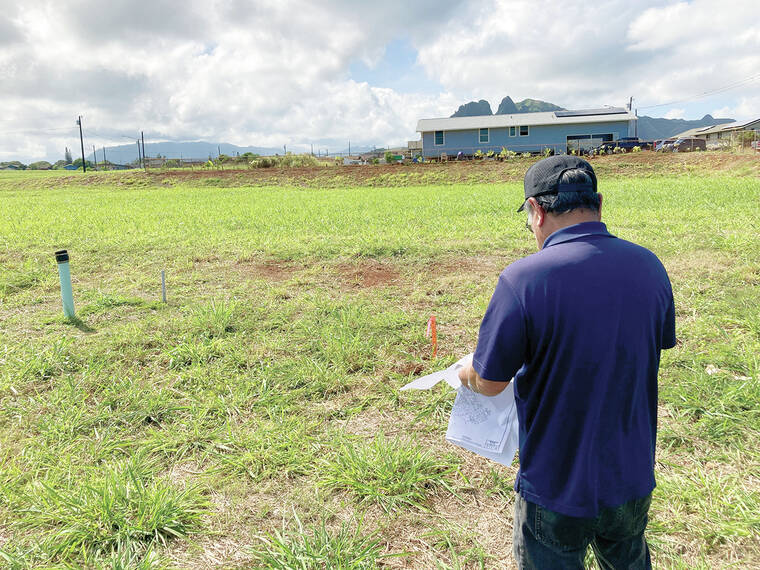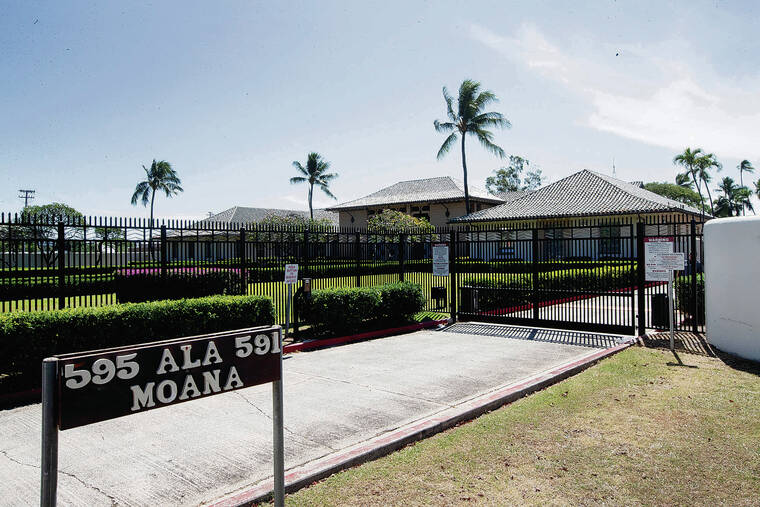ANAHOLA — Surveying work was completed last week on an Anahola project that will soon provide land to 51 families on the state Department of Hawaiian Home Lands waitlist.
The lots will be provided to beneficiaries vacant, and they will be responsible for constructing their own homes on the land.
“A beneficiary could build a multi-generational home or a tiny home. It’s a matter of what’s suitable for their family,” said DHHL Information and Community Relations Officer Cedric Duarte. “This is largely in response to beneficiary consultation. There’s more desire for the vacant-lot program so beneficiaries have flexibility to construct to their own needs.”
The 51 lots represent the second phase of the Pi‘ilani Mai Ke Kai subdivision project, which will ultimately include a total of 171 lots. In Phase I, 80 lots were awarded, and in Phase III an additional 40 will be set up.
Esaki Surveying &Mapping’s Dennis Esaki conducted the surveying work on the land, putting pins in the lots and painting numbers on the side of the road that will run through the new subdivision.
Esaki, who has surveyed and engineered many DHHL projects on Kaua‘i, reported that he had originally surveyed the land in 2018, but now five years later the lots have not been awarded.
“Now we have to come back and re-survey it,” said Esaki. “They said they’re going to award it for real this time.”
According to the DHHL, a federal wetland review stalled the project.
The lots range in size from 10,078 to 11,374 square feet, and are outfitted with most infrastructure — except a sewage system.
“Because there’s no sewer system, the lots have to be 10,000 square feet to allow for a septic
system,” said Esaki.
Beneficiaries will get the chance to select their lots in April. They will be sent a letter in order of their position on the wait-list and, after an orientation meeting, will be taken to the land to choose their lot.
Since there is no builder contracted to construct homes on the land, Duarte said, there is no financial pre-qualification for the selection of these lots.
DHHL case managers will guide the selected beneficiaries through the process of constructing a home on the land, utilizing resources and partnerships to provide assistance.
“We’ve worked with Habitat For Humanity in the past,” said Duarte. “And there may be some federal resources on the table.”
If families are unable to build on the land after two years, their lot will be returned and they will return to the waitlist.
The DHHL was established through the federal 1920 Hawaiian Homes Commission Act in an effort spearheaded by Kaua‘i native Prince Jonah Kuhio
Kalanianaole.
The act allows the department to provide those with at least 50% Hawaiian blood with 99-year homestead leases at an annual rate of $1, along with financial assistance through direct loans or loan guarantees for home construction, replacement or repair, and for the development of farms and ranches; technical assistance to farmers and ranchers; and the operation of water systems.
The agency — which has been systemically underfunded and often requires beneficiaries to remain on the waitlist for over a decade — could receive a major funding increase this year. Companion legislation, House Bill 2511 and Senate Bill 3329, which would both appropriate $600 million to the agency, both passed their respective chambers last week. The funding could get nearly 3,000 beneficiaries off the waitlist, Duarte said.
Among the projects that would be funded with this influx of cash are 75 additional vacant lots in Hanapepe. DHHL reported that this project would break ground at the end of 2023.
•••
Guthrie Scrimgeour, reporter, can be reached at 647-0329 or gscrimgeour@thegardenisland.com.






